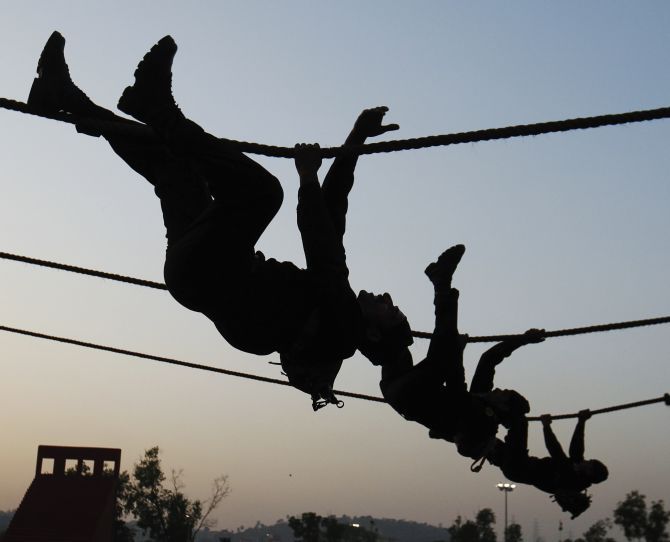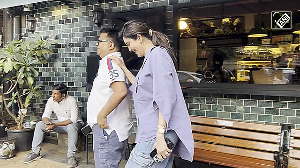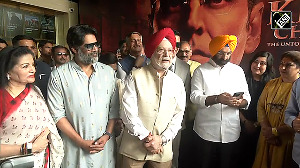How do you get to wear the prized maroon beret and the treasured Balidan badge?
Veena Sandhu looks at the gruelling training para commandos undergo to become a part of the elite force equipped to carry out surgical strikes.

"When you are on a cross-border mission, you remember nothing -- neither family nor friends. But yes, there are flashes when your mother comes to mind," says an officer who has, in the past, participated in at least one strike across the Line of Control.
The September 29 surgical strikes on terrorist launch pads in Pakistan occupied Kashmir have put the spotlight on para commandos -- the elite special force that takes over in situations that demand a sharp, clinical mind, extraordinary levels of physical fitness, but most of all, unshakable integrity.
"To question the veracity of the surgical strikes is akin to questioning a para commando's integrity," says a para commando, who, like every serving commando, does not want his identity to be revealed and, therefore, compromised.
A para commando's training, a 90-day probation period, puts him through near superhuman tasks to test his character values and integrity, besides, of course, his physical strength and decision-making abilities.
"By the end of these three months, 85 per cent of the trainees, which include officers, junior and non-commissioned officers as well as other ranks (jawans), either opt out or are eased out," says an officer.
The 'stretch gates' (the limits you are pushed to) have 50 per cent of dyed-in-the-wool soldiers breaking down and exiting in the first week itself.
A month down on an average another 25 per cent drop out.
Finally, only about 15 per cent of the best of the best make it to the finish line and earn the honour of wearing a maroon beret and the 'Balidan Badge,' a red badge with flaming wings and a dagger, on their right pocket, below the name plate.
"The Balidan Badge symbolises that you have surrendered your good life to the nation; that you have already made the supreme sacrifice," says defence analyst Danvir Singh, a retired colonel and author of Kashmir's Death Trap: Tales of Perfidy and Valour.
Existing soldiers -- officers and jawans from regular services like the infantry, artillery, engineers, corps of signals and so on -- can volunteer to become para commandos.
Others can opt for it directly after getting commissioned or while they are training as a cadet in one of the military academies.
Then begins the gruelling probation. "A physical activity could stretch for 96 hours straight, without any sleep," says a young para commando.
The task could include running from 10 to 60 km with 22 kg of weight on your back, even at night, where your navigation skills are also put to test.
"When you stop feeling the pain, it's then that your actual work starts," says the officer.
Since they have a very high level of mental robustness and survival skills, after the training they can go without food and water for 72 hours, says Singh.
The diet is high-calorie, where a commando consumes about 4,000 calories a day.
Specialised skills, like deep-sea diving and underwater operations, demolition expertise, cliff climbing, camouflage and concealment techniques, explosive handling, unarmed combat, weapon and navigation skills, like finding your way by reading the stars, are all taught.
The training in paratrooping is also specialised, with parachuting methods like 'high altitude low opening' and 'high altitude high opening.'
"Both are carried out with oxygen masks because of the rarefied atmosphere at the high altitudes from where they jump," says Colonel Singh.
In a HALO exercise, the paratrooper, armed with battle load, will fall freely at high velocity and open the parachute at a very low altitude.
HALO is for immense surprise, and for stealth insertion, where you land straight on the target, without a warning.
HAHO allows the para commando to open the parachute at a high altitude and then glide into the enemy area, even travelling up to 50 km inside the territory.
The commando opens the parachute barely 10 to 15 seconds after the jump, then uses a compass or a GPS device to guide him to his target. He is also equipped to study the terrain features for navigation.

While nothing has emerged clearly about the method the para commandos used to conduct the recent strikes, there are three possibilities, says Colonel Singh: Ground insertion and ground extrication; hector (helicopter) insertion and ground extrication; or ground insertion and hector extrication.
"On that particular night, there was troop movement from 9, 10 and 11 Corps from the barracks to the Intelligence Bureau. They returned by first light," says Colonel Singh. "It was a show of movement, which was part of larger deception."
Such activity, he adds, was carried out all along the LoC, augmented by artillery and small arms fire. "There was also helicopter movement along the LoC, basically to confuse the enemy. The helicopter movement, in fact, implies that helicopters were used either for insertion or extrication."
To successfully pull off such an operation, every para commando should be able to blindly trust every other man in his team.
So, only those who inspire such blind trust finally get to become para commandos. Every task throughout the probation tests this key quality.
"Your moral compass is always under scrutiny," says a young para commando. Both jawans and officers undergo the same training in the same space, eating together and sharing living quarters. "Not just the instructors, everybody -- the person you are dining with, the men who sleep to your left or right, even the person who comes to sweep your room -- is watching you and giving feedback about you," says the officer.
They scan the soldier for everything: Is he the kind of person who returns to the room and chooses to sleep instead of completing the task, or does he finish the job no matter how exhausted he is?
How does he react when men give him a task?
Is he a friendly guy?
Does he perform superbly only in a good situation and shams and shirks when under pressure?

During the course of the training, the aspiring para commando is given innumerable tasks. He could be sent to a graveyard and told to find the oldest grave and return with the inscription on it.
"Or, the instructor might tell you at midnight that he needs a particular case study by early morning," says the officer. So, you go to the battalion library, request the guard to open it for you, find that particular book and prepare the report.
"You can do this only if you have been to the library in your free time and checked what all books are there," he says.
The aim is to judge whether or not the soldier is constantly keeping himself informed, even when he is unsupervised.
All kinds of conventional and non-conventional scenarios are posed to him to see how he reacts, the plan he comes up with and how feasible it is on the ground.
"This is both your training and assessment," says a para commando.
Immediately after every task, men in the team give their feedback. "A jawan might stand up and openly tell everybody gathered where the officer, who is the team leader, faltered and it is taken as a lesson to improve," says a senior para commando.
The man who finally emerges wearing the Balidan Badge on his chest is made of different stuff.
The stories of these soldiers, during confrontations and in times of peace, vouch for this.
An officer recalls how a para commando who had taken five bullets while chasing a terrorist, none of which luckily damaged any of his vital organs, refused to be treated as a 'low medical category' case.
As a low medical category, he would be entitled to better benefits on retirement and would face easier physical tests for promotion. "Yet, during a friendly competition in the regiment, he did 1,143 sit-ups and stopped only when he realised there were other jobs to be done," recounts the officer, laughing.
Another soldier, who had lost his right-hand index finger -- the firing finger -- practised firing with his left hand for three months. He then went back to the medical officer who had said he would be declared a low medical category and challenged him: "Test me now."
That, in a way, sums up what a para commando stands for.







 © 2025
© 2025